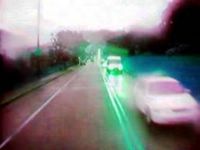filmaking robot dreams in 20 dimensions
A filmmaking robot
This robot makes short films based on its visual experience. Its eyes travel about the city on buses while the body sits in a gallery. The eyes collect snippets of video, and transmit them to the body when their buses come within range of a Cafenet wireless internet node. The robot body splits the video into individual frames and analyses each one, obtaining twenty numbers reflecting the arrangement of colour, shape and detail within the frame. These numbers are treated as coordinates in a twenty dimensional space, in which distance is somewhat related to visual difference. For twelve hours a day the robot traces a zigzagging path through this space. This path passes through a series of images, which become a video sequence.

Visitors to the gallery can see this video, called variously the robot's "dream" or "stream of consciousness". At the end of the day the robot looks over its days work and joins the best parts together as a finished film.
In addition to getting images from the eyes, the robot creates false memories by combining and manipulating well-liked and overused images.

The robot develops false memories of things it has not seen. It dwells upon the images it thinks are good or unique, and combines and distorts these to create new images. It reproduces the good images to improve the overall quality of its memory, and the unique ones to fill up sparsely populated patches in its memory space. Images in these holes tend to be chosen whenever the robot's mind wanders that way, resulting in overused motifs. By making imperfect copies of these images, the robot tries to fill holes in its memory space, allowing freer drift of attention.

A filmmaking robot
This robot makes short films based on its visual experience. Its eyes travel about the city on buses while the body sits in a gallery. The eyes collect snippets of video, and transmit them to the body when their buses come within range of a Cafenet wireless internet node. The robot body splits the video into individual frames and analyses each one, obtaining twenty numbers reflecting the arrangement of colour, shape and detail within the frame. These numbers are treated as coordinates in a twenty dimensional space, in which distance is somewhat related to visual difference. For twelve hours a day the robot traces a zigzagging path through this space. This path passes through a series of images, which become a video sequence.

Visitors to the gallery can see this video, called variously the robot's "dream" or "stream of consciousness". At the end of the day the robot looks over its days work and joins the best parts together as a finished film.
In addition to getting images from the eyes, the robot creates false memories by combining and manipulating well-liked and overused images.

The robot develops false memories of things it has not seen. It dwells upon the images it thinks are good or unique, and combines and distorts these to create new images. It reproduces the good images to improve the overall quality of its memory, and the unique ones to fill up sparsely populated patches in its memory space. Images in these holes tend to be chosen whenever the robot's mind wanders that way, resulting in overused motifs. By making imperfect copies of these images, the robot tries to fill holes in its memory space, allowing freer drift of attention.

A filmmaking robot

1 Comments:
20 Dimensional Dreamers
good name for a band
Post a Comment
Subscribe to Post Comments [Atom]
<< Home